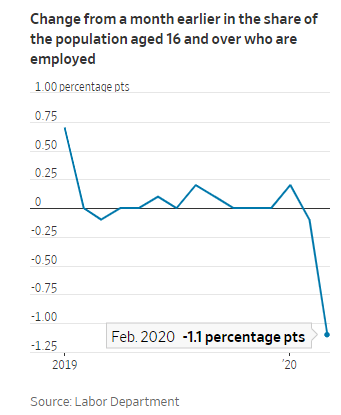Stunning as the drop in jobs in March was, it masked the true depth of the decline. And it is just the beginning
By Justin Lahart

A man delivering food this week in Beverly Hills, Calif. / Photo: apu gomes/Agence France-Presse/Getty Images .
In the waning days of winter, America’s job engine shuddered to a halt.
Friday’s employment report was stunningly grim. The Labor Department reported that the economy shed 701,000 jobs in March—far more than the modest loss of 10,000 jobs economists expected, on average.
The unemployment rate jumped to 4.4% from February’s 3.5%, marking its largest percentage-point increase since 1975. Economists were predicting 3.7%.

What actually happened was even worse than what those headline numbers showed, with more like three million people losing their jobs. And the bad news has only just begun.
The reason most economists got their estimates so wrong was that the surveys upon which the Labor Department bases its jobs numbers reflect the pay period that includes the 12th of the month. That was before shutdowns enacted in response to the novel coronavirus crisis began rolling across the country and before the number of workers filing new claims for jobless benefits shot higher.
Indeed, jobless claims for the week ended March 14 came to just 282,000, higher than the 211,000 during the previous week but nothing like the 3.3 million reported for the following week, or the 6.65 million reported the week after that.
Part of what probably happened is that, while many employers still hung on to the workers they had, they simply stopped hiring. That matters because, in any given month, there is substantial churn in the labor market.
Millions of workers leave old jobs and get hired for new ones. A sudden slowdown can add up to a lot of job losses even without layoffs. There is also often a delay for some people between getting laid off from a job and applying for unemployment benefits.
The jump in the unemployment rate indicates that the number of people losing their jobs was even greater than what payrolls figures showed. That figure is based on how many people are on employers’ payrolls in a given week, while unemployment is based on a separate survey that asks whether people are employed, unemployed and looking for work, or neither.
The payroll report showed that the number of unemployed people increased by 1.35 million in March from February. That might have happened because employers laid people off but gave them one last paycheck.
That 1.35 million increase in the rolls of the unemployed doesn’t even include anyone who simply didn’t look for work and therefore wasn’t included in the unemployment rate. Looking for work when everything is shut down isn’t easy. The number of people counting themselves as employed fell by 3 million.
April will be even worse. They are calling this a recession, but the danger is that it becomes something deeper.
0 comments:
Publicar un comentario